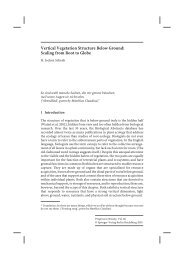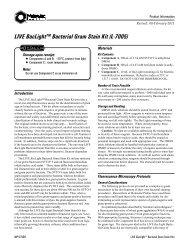Landscape Evolution at an Active Plate Margin - Biological Science ...
Landscape Evolution at an Active Plate Margin - Biological Science ...
Landscape Evolution at an Active Plate Margin - Biological Science ...
You also want an ePaper? Increase the reach of your titles
YUMPU automatically turns print PDFs into web optimized ePapers that Google loves.
D. R. Jessey <strong>an</strong>d R. E. Reynolds<br />
Figure 1-11. Generalized geologic cross section of the central Owens Valley. [D. R. Jessey]<br />
lies along the east edge of the Alabama Hills <strong>an</strong>d the<br />
Owens Valley fault about 0.6 miles to the east of th<strong>at</strong>.<br />
The scarp of the Inyo Mountains is cre<strong>at</strong>ed by the<br />
White–Inyo fault.<br />
The Alabama Hills lie 0.6–1.2 miles west of the town<br />
of Lone Pine, California. They form a prominent<br />
ridge of Cretaceous plutons <strong>an</strong>d Jurassic metavolc<strong>an</strong>ic<br />
<strong>an</strong>d metasedimentary rocks separ<strong>at</strong>ed from the<br />
main Sierra massif by the Independence frontal fault.<br />
Across the valley is the “famous” Union Wash ammonite<br />
locality <strong>an</strong>d the geologically complex Inyo<br />
Mountains. The Owens Valley <strong>an</strong>d Inyo Mountains<br />
lie near the western margin of the North Americ<strong>an</strong><br />
cr<strong>at</strong>on <strong>an</strong>d <strong>at</strong> the center of the central Sierra Nevada<br />
segment of the Cordiller<strong>an</strong> arc (Sorensen et al, 1998).<br />
The emplacement of the Sierra Nevada b<strong>at</strong>holith was<br />
a result of the oblique subduction of the Farallon<br />
oce<strong>an</strong>ic pl<strong>at</strong>e bene<strong>at</strong>h the North Americ<strong>an</strong> pl<strong>at</strong>e from<br />
210-80 Ma.<br />
The l<strong>at</strong>e Cenozoic tectonic history of eastern California<br />
is domin<strong>at</strong>ed by the Eastern California Shear<br />
Zone (ECSZ). The ECSZ is the name applied to the<br />
southern segment of the Walker L<strong>an</strong>e belt, a zone<br />
of dextral shear th<strong>at</strong> accommod<strong>at</strong>es about 20–25%<br />
of the total rel<strong>at</strong>ive motion between the Pacific <strong>an</strong>d<br />
North Americ<strong>an</strong> pl<strong>at</strong>es (G<strong>an</strong>, et al., 2000). North of<br />
the Garlock fault the ECSZ is 60 miles wide <strong>an</strong>d comprised<br />
of four separ<strong>at</strong>e north-northwest striking fault<br />
zones; from east to west the De<strong>at</strong>h Valley-Furnace<br />
Creek, Fish Lake Valley, Hunter Mountain–P<strong>an</strong>amint<br />
Valley, <strong>an</strong>d Owens Valley (Fr<strong>an</strong>kel, 2008). The Owens<br />
Valley fault is the only one of the four th<strong>at</strong> has<br />
recorded a major seismic event in the historic past.<br />
Le, et. al. (2007) published a comprehensive study of<br />
Sierra Nevada Frontal Fault (SNFF) system including<br />
the Independence fault, 5 miles to the west of Lone<br />
old as 10 Ma.<br />
Pine. Their study reported th<strong>at</strong><br />
movement along the Independence<br />
fault was dip-slip, east side<br />
down, <strong>at</strong> a r<strong>at</strong>e of 0.2–0.3 mm/<br />
yr. This r<strong>at</strong>e is about one-half to<br />
one-third th<strong>at</strong> necessary to accommod<strong>at</strong>e<br />
the 5000–7000 feet<br />
of vertical displacement between<br />
the Sierra Nevada crest <strong>an</strong>d the<br />
Owens Valley. They suggested<br />
this discrep<strong>an</strong>cy indic<strong>at</strong>es the Sierra<br />
Nevada Mountains are older<br />
th<strong>an</strong> the generally agreed upon<br />
figure of 3–5 Ma (Wakabayashi<br />
<strong>an</strong>d Sawyer, 2001), perhaps as<br />
The Lone Pine fault lies immedi<strong>at</strong>ely to the east of<br />
the Alabama Hills. The Lone Pine fault appears to be<br />
right, oblique-slip fault. R<strong>at</strong>es of vertical motion are<br />
estim<strong>at</strong>ed <strong>at</strong> 0.12–0.25 mm/yr. Horizontal slip r<strong>at</strong>es<br />
are less well constrained, but Lubetkin <strong>an</strong>d Clark<br />
(1988) suggest r<strong>at</strong>es ~1 mm/yr. The rel<strong>at</strong>ionship between<br />
the Lone Pine fault <strong>an</strong>d the Owens Valley fault<br />
to the east is enigm<strong>at</strong>ic. Since both were displaced<br />
by the 1872 Lone Pine earthquake they are clearly<br />
interrel<strong>at</strong>ed, however, Le et. al (2007) suggest th<strong>at</strong><br />
motion along the Owens Valley fault is almost pure<br />
dextral shear. Estim<strong>at</strong>es of slip r<strong>at</strong>e are variable from<br />
a high of 4.5 mm/yr (Kirby, et. al., 2008) to a low of<br />
0.7 mm/yr (Lubetkin <strong>an</strong>d Clark, 1988). No estim<strong>at</strong>es<br />
are available for the vertical component of movement<br />
along the Owens Valley fault, which m<strong>an</strong>ifests itself<br />
in the scarp cre<strong>at</strong>ed by the 1872 earthquake, but it is<br />
undoubtedly small; < 0.1 mm/yr.<br />
The White–Inyo fault strikes along the east side of the<br />
Owens Valley, 5–7 miles east of Lone Pine. Its history<br />
is complex. Bacon et. al. (2005) suggest th<strong>at</strong> Holocene<br />
motion along this fault is predomin<strong>an</strong>tly right<br />
oblique–slip <strong>at</strong> a r<strong>at</strong>e of 0.1–0.3 mm/yr. However,<br />
Beiller <strong>an</strong>d Zoback, (1995) argue th<strong>at</strong> motion along<br />
the White Mountains/Inyo Mountains fault system<br />
underwent a ch<strong>an</strong>ge from predomin<strong>an</strong>tly dip-slip<br />
(west side down) to oblique slip <strong>at</strong> 288 ka. This seems<br />
reasonable as the vertical component in <strong>an</strong> obliqueslip<br />
fault moving <strong>at</strong> a r<strong>at</strong>e of 0.1–0.3 mm/yr would<br />
be insufficient to account for the relief between the<br />
White/Inyo crest <strong>an</strong>d the valley floor.<br />
Richardson’s (1975) Master’s thesis from the University<br />
of Nevada–Reno was the first public<strong>at</strong>ion on the<br />
str<strong>at</strong>igraphy of Alabama Hills. The Jurassic sedimen-<br />
20 2009 Desert Symposium
















